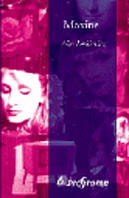
| HOME |
| NERVE |
| REVIEWS |
| ARCHIVE |
| EVENTS |
| LINKS |
| ABOUT US |
| CONTRIBUTORS |
| BACK ISSUES |
| CONTACT US |
 Maxine
Maxine
By Alice Lenkiewicz
Bluechrome Publishing, Paperback, £7.99
Reviewed by Sue Hunter
This is a mysterious book. I was quite baffled by it at first, but it kept me intrigued. It shifts about in time and space, between prose, poetry and play form. Characters change in character, and there were occasional diagrams that I could not understand.
The Maxine of the title is on a journey to learn how to float, which I felt meant a kind of letting go and a sort of astral travel. On her travels she meets various kinds of poets - some funnily accurate caricatures - and some famous painters from the past, acting out different roles with each of them. Sometimes she floats off into space, or inhabits a glass cube. Between the surreal events are down-to-earth scenes of a marriage with its tensions and of friendships with other women.
Episodes are based on drawings of women in a second hand book bought by the author, and on famous paintings such as Jan van Eyck’s ‘The Marriage of Arnolfini‘.
In a scene where she becomes the seventeenth century painter Artemesia - who was raped by her teacher Tassi - Maxine conflates the attack with the present-day ‘Poet F‘, who suffered a similar assault by her mentor. A beautiful poem about the pigment ultramarine contrasts with the violence of that scene:
'Gold flecks/ tiny gold flecks/ Iron Pyrites/ mineral forms/ in the presence of Sulphur/ elements/ Sodium, Aluminium, Silicon, Oxygen/ do not by themselves/ lend much colour to anything/ let alone/ an intense blue…………the Sulphur is the colour chemist’s/ Philosopher’s Stone/ Transmuting/ base mineral/ into something immeasurably/ more precious….'
Maxine seems to represent many women, and the dramatic events illustrate the differing roles of women through history. Her strange experiences are a way of finding out who she is - through fantasies and re-enactments of lovemaking, fear and anger, rape, and feelings of self-doubt.
Ending the book is a supposed interview with ‘Maxine’ and then ‘Alice‘, which explains the structure and meaning of the work. Even this section is puzzling; I think the author is trying to be as ambiguous and teasing as before. I found the intellectual explanation hard to understand, but enjoyed the book best on an emotional level, just accepting its constantly shifting shapes and time zones, characters and contradictions.
My only reservation is that Alice Lenkiewicz tried to say too many things in too many ways in a single book.
If you would like to buy this book visit: www.amazon.co.uk
It can also be bought from News
From Nowhere on Bold Street.